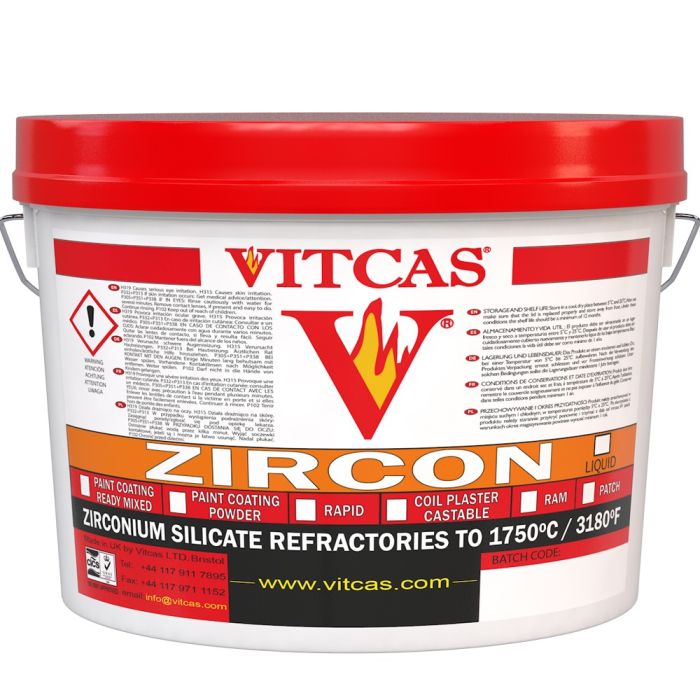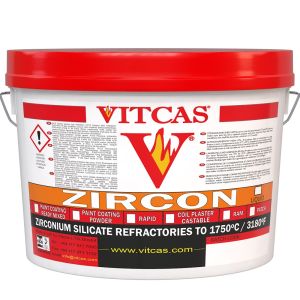Zircon Coil Plaster Castable 1750°C
High-Performance Zircon-Based Fine-Grained Refractory Castable
VITCAS Zircon Coil Plaster is a fine-grained refractory castable formulated with zirconium silicate as the primary aggregate, offering exceptional thermal resistance up to 1750°C (3180°F). With a particle size below 1 mm, it is ideal for precision applications where conventional castables, with coarser grain sizes, are unsuitable.
Supplied in dry form, the refractory castable is mixed with water to produce a smooth, trowellable consistency, making it suitable for application in complex geometries and confined spaces. Unlike thin zircon paints or surface washes, Zircon Coil Plaster functions as a structural refractory plaster, providing load-bearing and protective linings. Its zircon content offers outstanding resistance to molten metal and glass wetting, while its plaster form allows for dense, uniform application in intricate areas and complex shapes.
Key Features
-
Zirconium Silicate-Based: Offers excellent thermal stability and chemical resistance
-
Fine Grain Size (<1 mm): Suitable for precision applications where standard castables are too coarse
-
Hydraulic Setting: Enables easy installation and setting at ambient temperatures
-
High-Temperature Resistance: Withstands continuous service up to 1750°C (3180°F)
-
Dry Powder Form: Requires only water to mix into a trowellable plaster
Industrial Applications
Metallurgical Industry: • Coating and sealing of electric induction furnace coils • Protection against molten metal penetration in copper, aluminium, and steel foundries
Power Generation: Insulation and protection of electrical heating elements in resistance heating systems
Chemical Processing: Localised patching or protective linings in corrosive and high-temperature process vessels
Glass Industry: • Dense refractory lining in areas exposed to molten glass - resists sticking and infiltration • Backing layer behind zircon paint coatings to extend service life • Lining of moulds, troughs, and feeders where fine-grain, non-wetting refractory is needed
Ceramics Industry: • Structural lining of kiln furniture, saggars, or setters where glaze contact may occur • Precision repairs and linings in small, high-temperature kilns and bench-top furnaces
Aerospace Industry: • High-temperature refractory linings in sintering furnaces for ceramic and metallic components • Chemically inert thermal barriers in propulsion test facilities and thermal simulation chambers
Petrochemical and Refining: • Structural lining of small-diameter flues, burner blocks, or reaction tubes exposed to thermal cycling • Patch repairs and complex refractory protection in confined geometries
Metal Additive Manufacturing (3D Printing): • Non-stick refractory linings in powder-bed fusion and sintering systems with embedded heating elements • Precision insulating layers in compact kilns for controlled sintering operations
Research and Laboratory Furnaces: • High-performance lining for lab-scale induction or resistance furnaces • Ideal for relining or patching in setups where standard castables are too coarse
Automotive and Tool Manufacturing: • Furnace repairs in die-casting or forging environments where precision application is required • Anti-wetting refractory lining around flux channels or molten alloy contact points
Installation Guidelines
- Preparation: Use appropriate personal protective equipment (PPE), including gloves, safety goggles, and a dust mask when handling the dry material.
- Mixing: Gradually add clean water to the dry powder while mixing mechanically or manually until a uniform, smooth, and trowellable consistency is achieved.
- Application: Apply the mixed plaster to the prepared substrate using a trowel or similar tool. Ensure full surface contact and eliminate air pockets or gaps.
- Curing: Allow the castable to air-dry and set according to the manufacturer's recommendations before exposing it to high-temperature service.
| Product Group | Refractory Products |
|---|---|
| Size | 25kg |
| HS Tariff Code | 3816009000 |









